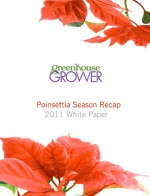Poinsettia Season 2010 Recap: Making The Most Of Poinsettias

Of all the floriculture crops currently being produced, the poinsettia might be the one that concerns growers the most. From rock-bottom retail prices and high production costs to oversaturation of existing markets and a lack of developing ones, more growers are walking away from poinsettias these days.
Last year, when Greenhouse Grower first revived its poinsettia survey from the early 2000s, 3.6 percent of growers who produced poinsettias in 2009 indicated they would not grow them again in 2010. This year, when we again asked growers if they plan to grow poinsettias in 2011, 7.4 percent say they won’t grow poinsettias when the time comes later this year.
No, that 7.4 percent figure isn’t overwhelming. It is, however, somewhat alarming that fewer growers are committing to poinsettias. A few other poinsettia survey findings may raise your eyebrows, as well:
– More than 40 percent of growers admit they produce poinsettias primarily to cover their fixed overhead costs, not to increase their operation’s profit margin.
– Twelve percent of growers say current wholesale poinsettia prices are too high.
– Six percent of growers say current retail poinsettia prices are too high, and 30 percent say prices are just right.
Another poinsettia sentiment a number of growers echoed in our survey is that retail quality has improved tremendously, particularly at box stores. Pricing becomes a major issue for some growers, though, when box store quality equals the quality independent retailers provide.
“Lowe’s and (Home Depot) selling good quality for one-third (the price) of our retail (is a concern),” says Carrie Engel, a grower-retailer at Valley View Farms. “We do attempt to differentiate with service, quality and all the usual stuff. My own sister had Sam’s (Club) poinsettias at Christmas and, to be honest, they looked great.”
Adds Stuart Hunt, a wholesale grower at Oyen Greenhouses in Canada: “Plants from everyone were generally good. It made it harder to sell a premium poinsettia. Large greenhouses kept the prices down for most sizes.”
Competition & Pricing
Considering quality improved at a number of retailers, perhaps it’s no surprise competition was the biggest obstacle for many growers regarding poinsettias. In our survey, we listed nine obstacles and asked growers which of the nine is their biggest hurdle. Nearly one-third of growers indicate competition was their biggest hurdle while 30.3 percent say pricing was.
Last year, when we asked the same question, pricing was the overwhelming top hurdle at 36.1 percent. In fact, competition was almost a non-issue based on survey findings. The percentage concerned about competition a year ago was equal to the percentage concerned about poinsettia marketing.
Regardless of the percentages, both competition and pricing are great concerns to many growers.
“This crop more than any other is all about asking price versus relevance in the market,” says Phil DeGoede, a wholesale grower at DeGoede Brothers. “We are always left wondering if our prices will hold up in the future.”
Based on our survey findings, several 2009 wholesale prices did not hold up in 2010 (Table 1). We asked growers to list the average wholesale prices they received for various sizes, and only 6- and 8-inch poinsettia prices increased on average. Eight-inch wholesale prices increased tremendously, in fact, from $8.45 in 2009 to $14.22 in 2010. Average wholesale prices of three other pot size categories–4.5 inch, 6.5 inch and 10 inch–decreased.
Retail prices, on the other hand, made strides as a whole (Table 2). Of the five size categories we asked about the last two years, only 6.5-inch poinsettias drew less in 2010 on average than they did in 2009. On average, 6 inch drew a dollar more, 10 inch drew two dollars more and 8 inch drew four dollars more.
“Movement on 8 inch and 10 inch were strong,” says Ed Fairweather, a wholesale grower at Wessels Farm.
Adds Jane Loppnow, a grower-retailer at Waukesha Floral & Greenhouse: “Larger poinsettias and specialty poinsettias sold best.”
Other Takeaways
Although competition and pricing are the two obstacles road-blocking growers the most, new varieties and improved marketing and packaging are necessary to make poinsettias worth a grower’s while.
“People are tired of the same old look,” Fairweather says. “We tried a new product and did side planting. Wow! We were pre-sold out weeks in advance.”
Emily Chockley, a wholesale grower at Green Circle Growers, has a few market observations and ideas to improve poinsettia sales.
“Glitter is still popular but painted is out,” Chockley says. “Bicolors and tricolors help to complete the product assortment. Poinsettia foliage planters need to be expanded on, as these are nice companions alongside the traditional poinsettias. Smaller poinsettia gift options as the holiday draws near capture last-minute sales as customers make their way to holiday parties. We still need a ‘true’ white poinsettia.”









